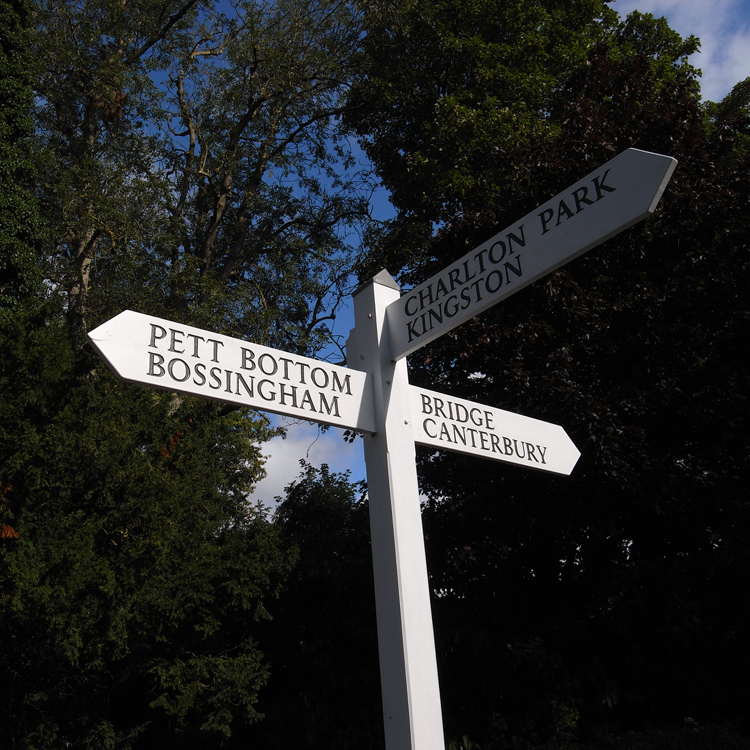For the most part, we tend to see the names of towns, villages and hamlets as no more than geographical markers to help us to get from A to B or for the postman to deliver our mail. The most comical might raise the odd titter (step forward, the lavatorially named Pett Bottom, Pratt’s Bottom and Lynsore Bottom) and occasional spate of good-humoured vandalism: the good folk at Pett Bottom, for instance, are besieged by wags changing their road signs to ‘Pert Bottom’. Whilst some names might raise an eyebrow of bemusement (Plucks Gutter, anyone?), we largely take such identity markers for granted. So what is in a (Kentish) name?
- Ing/Inge: The suffix ‘ing’ or ‘inge’ means ‘people’, thus Ottinge derives from ‘Otta’s people’. e.g. Sellindge, Beltinge, Pedlinge, Ottinge, Hawkinge, Ospringe.
- Ham: From the Old English for village or homestead. Alkham and Wingham are particularly interesting: ‘alh’ is Anglian for ‘heathen temple’, whilst ‘wig’ is Old English for a shrine, so the villages are likely to describe their origins as holy sites. e.g. Alkham, Rainham, Petham, Wingham.
- Den: A common suffix in the Weald, den at the end of a place name denotes a woodland pasture. This is often connected to a personal name (Biddenden refers to Bionna’s pasture, for instance) but can also be a descriptor of a particular type of land or activity, such as Smarden (pasture where lard is produced). e.g. Tenterden, Biddenden, Smarden, Horsmonden, Bethesden.
- Hurst: Another popular one in the Weald, this originates in the Old English for a wooded hill, thus Lamberhurst conveys a wooded hill where lambs graze and Hawkhurst, a wooded hill inhabited by hawks. e.g. Hawkhurst, Lamberhurst, Goudhurst, Speldhurst.
- Borough: Towns with ‘borough’ at the end of their name are found across the UK but the suffix has a distinct sense in Kent, Surrey and Sussex, indicating a historic administrative unit, or tithing, which originates from the Angl0-Saxon for a pledge. This is different from the other sense of ‘borough’, which means a town with special status. e.g. Southborough, Hildenborough.
- Bourne: Exemplified in the cluster of villages (Bekesbourne, Littlebourne and Patrixbourne) to the east of Canterbury, this suffix is a sign that a stream is nearby. In this case, they all nestle near to the Stour. e.g. Sittingbourne, Shipbourne, Bekesbourne, Littlebourne, Patrixbourne.
And as for Pett Bottom? The history of that one’s still a mystery.
To find out more about the origins of Kentish place names, the Nottingham University site below is an excellent resource. Simply click on the red dot of the place you want to research and the information will pop up.
http://kepn.nottingham.ac.uk/map/county/Kent

What about Upper and Lower Hardres?
Lynsore Bottom?
LikeLike
I’ve had a look on the Nottingham University interactive map. Hardres = wood, so it is upper and lower wooded area. Unfortunately, they haven’t provided an answer on Lynsore Bottom… I’ll try to find out! http://kepn.nottingham.ac.uk/
LikeLike